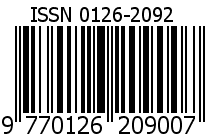THE POTENTIAL OF JAMBU KELING (Syzigium cumini) LEAVES AS A CANDIDATE FOR HYPERTENSION HERBAL THERAPY: A REVIEW
Abstract
Hypertension or elevated blood pressure is a serious medical condition that significantly increases the risks of heart, brain, kidney, and other diseases. The number of adults with hypertension increased day by day. Certain health conditions, such as diabetes and obesity, can also increase the risk of developing hypertension. The treatment of hypertension is lifestyle changes and medication. Patient with hypertension usually does not take their medication due to its side effects and expensive cost. Herbal therapy is very much developed lately, due to its low price, abundant availability in nature, and minimum side effects. The objective of this study is to find out the potential of Syzigium cumini leaves as a candidate for hypertension herbal therapy. This research is a literature review study using secondary data from related research. Syzigium cumini leaves contain flavonoids and/or triterpenes that exert antihypertensive effects through the combination of the vasodilatory and antioxidant activities of these classes of compounds. Syzygium cumini leaves reduce the blood pressure and heart rate of spontaneously hypertensive rats in some in vivo and in vitro studies. This antihypertensive effect is probably due to the inhibition of arterial tone by the blockade of extracellular Ca2+ influx.
Keywords: Syzygium cumini, Hypertension, Herbal therapy.Keywords
Full Text:
PDFReferences
Iqbal AM, Jamal SF. Essential hypertension. StatPearls [Internet] 2020;
WHO. Hypertension. WHO2021;
Kemenkes RI. Hipertensi Si Pembunuh Senyap. Kementrian Kesehat RI 2019;1–5.
Oparil S, Acelajado MC, Bakris GL, Berlowitz DR, Cífková R, Dominiczak AF, et al. Hypertension. Nat Rev Dis Prim 2018;4:18014.
Goff DCJ, Lloyd-Jones DM, Bennett G, Coady S, D’Agostino RB, Gibbons R, et al. 2013 ACC/AHA guideline on the assessment of cardiovascular risk: a report of the American College of Cardiology/American Heart Association Task Force on Practice Guidelines. Circulation 2014;129(25 Suppl 2):S49-73.
Ettehad D, Emdin CA, Kiran A, Anderson SG, Callender T, Emberson J, et al. Blood pressure lowering for prevention of cardiovascular disease and death: a systematic review and meta-analysis. Lancet (London, England) 2016;387(10022):957–67.
Kibiti C, Afolayan A. Herbal therapy: A review of emerging pharmacological tools in the management of diabetes mellitus in Africa. Pharmacogn Mag 2015;11(44).
General Guidelines for Methodologies on Research and Evaluation of Traditional Medicine World Health Organization. 2000;
Hall ME, Hall JE. Pathogenesis of hypertension. Hypertens A Companion to Braunwald’s Hear Dis E-Book Philadelphia Elsevier 2017;33–51.
Mikael L de R, Paiva AMG de, Gomes MM, Sousa ALL, Jardim PCBV, Vitorino PV de O, et al. Vascular aging and arterial stiffness. Arq Bras Cardiol 2017;109:253–8.
Jordan J, Kurschat C, Reuter H. Arterial hypertension-diagnosis and treatment. Dtsch Arztebl Int 2018;115(33–34):557–8.
Vangen-Lønne AM, Wilsgaard T, Johnsen SH, Løchen ML, Njølstad I, Mathiesen EB. Declining Incidence of Ischemic Stroke: What is the Impact of Changing Risk Factors? the Tromsø Study 1995 to 2012. Stroke 2017;48(3).
Sah AK, Verma VK. Syzygium cumini: An overview. J Chem Pharm Res 2011;3(3):108–13.
Srivastava S, Chandra D. Pharmacological potentials of Syzygium cumini: A review. J Sci Food Agric 2013;93(9):2084–93.
Chagas VT, França LM, Malik S, Paes AM de A. Syzygium cumini (L.) skeels: A prominent source of bioactive molecules against cardiometabolic diseases. Front Pharmacol 2015;6(259):1–8.
Ribeiro RM, Pinheiro Neto VF, Ribeiro KS, Vieira DA, Abreu IC, Silva S do N, et al. Antihypertensive Effect of Syzygium cumini in Spontaneously Hypertensive Rats. Evid Based Complement Alternat Med 2014;2014:605452.
Artanti N, Maryani F, Dewi RT, Handayani S, Dewijanti ID, Meilawati L, et al. in vitro Antidiabetic, Antioxidant and Cytotoxic Activities of Syzygium cumini Fractions from Leaves Ethanol Extract. Indones J Cancer Chemoprevention 2019;10(1):24–9.
Septiani R. Uji Aktivitas Antioksidan Ekstrak dan Fraksi Daun Jamblang (Syzigium cumini L.) dengan Metode DPPH [Internet]. 2018;Available from: http://repositori.usu.ac.id/handle/123456789/3874
Abreu IC, Silva SN, Ribeiro RM, Baima CFS, Olea RSG, Borges ACR, et al. Efeito dos extratos de Jatropha gossypiifolia L., Passiflora edulis Sims, Syzygium jambolanum DC na disponibilidade de ıons cálcio. Rev Ciências da Saúde 2002;4:41–6.
Schmid-Schönbein GW. Analysis of inflammation. Annu Rev Biomed Eng 2006;8(1):93–151.
Curin Y, Andriantsitohaina R. Polyphenols as potential therapeutical agents against cardiovascular diseases. Pharmacol Rep 2005;57 Suppl:97–107.
Xiao H, Zhang Y, Kong D, Li S, Yang N. The Effects of Social Support on Sleep Quality of Medical Staff Treating Patients with Coronavirus Disease 2019 (COVID-19) in January and February 2020 in China. Med Sci Monit 2020;26:e923549–e923549.
Rachel MR, Matheus BC, Ellen J da SPM, Gizele OSS, Iracelle CA, Vicente FPN, et al. Extract and chloroform fraction from Syzygium cumini leaves with vasorelaxant effect mediated by inhibition of calcium channels. African J Pharm Pharmacol 2018;12(12):151–8.





















